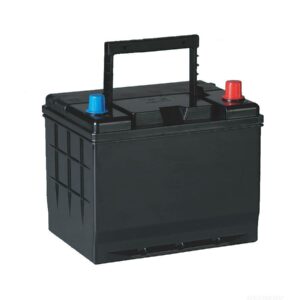
How Do Technological Advancements Shape Starter Battery Trends?
Lithium-ion batteries are replacing traditional lead-acid variants due to higher energy density (up to 4x), lighter weight, and longer lifespans. Innovations like nano-coated electrodes and thermal management systems optimize performance in extreme temperatures. Companies like Tesla and BMW now integrate lithium-ion starter batteries to support advanced vehicle electronics and start-stop systems efficiently.
What Are the Future Innovations in Car Starter Batteries?
Recent breakthroughs in cathode material engineering have enabled lithium-ion batteries to achieve charge cycles exceeding 5,000 while maintaining 80% capacity. Manufacturers are also adopting silicon-dominant anodes, which boost energy density by 20% compared to conventional graphite designs. The table below illustrates key performance comparisons:
| Parameter | Lead-Acid | Lithium-Ion |
|---|---|---|
| Energy Density (Wh/kg) | 30-40 | 150-200 |
| Cycle Life | 200-300 | 2,000-5,000 |
| Charge Time | 6-8 hours | 1-2 hours |
Automakers are leveraging these advancements to meet stricter emission regulations. For instance, Ford’s F-150 Lightning uses lithium-ion starter batteries that withstand -40°C temperatures through proprietary electrolyte formulations. Simultaneously, cost reductions from scaled production (28% decrease since 2018) make this technology accessible for mainstream vehicles.
How Is AI Optimizing Starter Battery Performance and Lifespan?

AI-driven analytics platforms, like those from Accenture and IBM, analyze usage patterns to calibrate charging cycles and prevent over-discharge. Machine learning models predict degradation rates with 90% accuracy, enabling proactive maintenance. This reduces replacement costs by 40% and aligns with predictive maintenance trends in Industry 4.0.
How to Maintain and Troubleshoot Common Car Starter Battery Issues?
Advanced neural networks now process data from 15+ battery parameters, including internal resistance and state-of-health metrics. These systems autonomously adjust charging voltages within 0.01V precision, extending calendar life by 3-5 years. Bosch’s BMS-X platform demonstrates this capability, having reduced warranty claims by 62% in commercial fleets through adaptive load balancing.
| AI Feature | Impact |
|---|---|
| Dynamic Charging Profiles | 18% Faster Charging |
| Anomaly Detection | 75% Fewer Failures |
| Capacity Forecasting | ±2% Accuracy |
The integration of edge computing allows real-time analysis without cloud dependency, critical for military and aerospace applications. Companies like Panasonic now embed microcontrollers directly in battery packs, executing AI algorithms locally to optimize performance under varying load conditions.
“The shift to solid-state and lithium-ion starter batteries isn’t just about performance—it’s a strategic move toward sustainability,” says Dr. Elena Torres, Chief Engineer at Redway Energy Solutions. “By 2030, AI-integrated systems will autonomously manage vehicle power networks, slashing emissions and maximizing resource efficiency. The key challenge lies in scaling production while maintaining cost-effectiveness.”
News
Sodium-Ion Batteries Revolutionize Starter Battery Performance
Recent advancements in sodium-ion battery technology have enabled their deployment in starter batteries, offering enhanced cold-weather reliability and safety compared to traditional lithium batteries, with Chinese manufacturers leading large-scale production initiatives.
Solid-State Battery Breakthroughs Enhance Starter Battery Safety
Innovations in solid-state electrolytes are being adapted to starter batteries, providing higher energy density and eliminating flammability risks, positioning this technology as a game-changer for automotive starting systems.
AI-Driven Battery Management Systems Optimize Starter Battery Lifespan
Integration of artificial intelligence in battery monitoring allows real-time health assessment and predictive maintenance for starter batteries, reducing failure rates by up to 30% in extreme temperature conditions.
FAQ
- Can lithium-ion starter batteries work in cold climates?
- Yes, advanced thermal management systems maintain efficiency even at -30°C.
- Are solid-state batteries available for commercial vehicles today?
- No, most remain in testing phases, with mass production expected post-2025.
- How do smart batteries reduce maintenance costs?
- Real-time diagnostics and predictive alerts minimize unexpected failures and extend service intervals.
Know more:
What Factors Are Fueling the Car Starter Battery Market Expansion?
How Do Technological Advancements Shape Starter Battery Trends?
Who Are the Key Competitors in the Market?
Global Car Battery Demand: Regional Trends, Drivers, and Market Dynamics
How Do Environmental Regulations Influence Battery Manufacturing Trends?
What Consumer Preferences Drive Competition Among Brands?
How Do Lithium-Ion Innovations Impact Automotive Starter Batteries?
Lithium-ion advancements enable lighter, longer-lasting starter batteries with faster charging than lead-acid. Higher energy density improves cold-cranking performance, while reduced maintenance lowers costs. Adoption remains limited by higher upfront pricing, but hybrid/EV models increasingly leverage these benefits.
What Sustainable Materials Are Used In Next-Gen Starter Batteries?
Recycled lead, bio-based separators, and non-toxic electrolytes reduce environmental impact. Companies like Northvolt use lignin from paper waste for cathodes. Sustainable designs prioritize circular economy principles, minimizing mining reliance and improving recyclability. Trade-offs include balancing durability with eco-friendly material costs.
How Does EV Adoption Drive Starter Battery Technology Shifts?
EVs demand 12V batteries compatible with high-voltage systems and frequent start-stop cycles. Lithium-ion and enhanced AGM batteries replace traditional lead-acid for efficiency. Integration with regenerative braking and infotainment loads pushes smart BMS adoption. EVs also prioritize lightweighting to extend driving range.
How Do Smart BMS Enhance Starter Battery Efficiency?
Smart BMS monitors voltage, temperature, and charge cycles to prevent overcharging/undercharging. Predictive algorithms extend lifespan by 20-30%. Real-time diagnostics alert users to faults, reducing failure risks. Systems like Tesla’s optimize energy use between 12V and main batteries, cutting parasitic losses.
What Role Does Nanotech Play In Starter Battery Performance?
Nanomaterials like graphene oxide boost electrode conductivity, enabling faster charge/discharge. Nano-coated separators improve thermal stability and ion flow. Research focuses on silicon nanowire anodes to replace lead, enhancing capacity. Nanotech also reduces sulfation in lead-acid batteries, extending cycle life.
What Are Future Trends In Renewable-Starter Battery Integration?
Solar-charged 12V batteries for auxiliary power and V2G (vehicle-to-grid) systems are emerging. Starters may store excess solar/wind energy for hybrid engines. Companies like Tesla explore bidirectional charging, letting cars power homes. Integration focuses on reducing grid dependency and aligning with net-zero goals.
